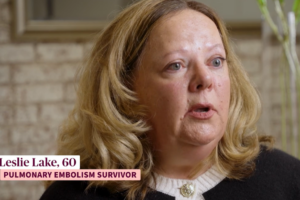Blood Clots in the United States
 By the Numbers:
By the Numbers:
The Public Health Burden Associated with Blood Clots
Blood clots affect many people — people from all walks of life — and no one person is any less important than another. It’s difficult to look at the numbers below, and not think of the individuals — their families, their friends — and not ask oneself, “Could I be at risk for a blood clot?” The answer most certainly is, “Yes, anyone can be affected by blood clots.” Blood clots do not discriminate.
Tragically, too many lives are affected by blood clots, and too many lives are lost because public awareness about life-threatening blood clots is so low. Study after study has shown that fewer than 1 in 4 people have any recognition of blood clots or their signs and symptoms.
Consider this:
On Average, 274 People Die Every Day from Blood Clots
- 107 to 130 cases of potentially deadly blood clots occurred each year per 100,000 Caucasian individuals from 1985 through 2002. This translates into about 1 to 3 cases per 1,000 people.
- 250,000 cases of potentially deadly blood clots, such as deep vein thrombosis or DVT, occurred each year between 1966 through 1990.
- 900,000 cases per year are now suggested by recent scientific modeling and public health statistics.
- 100,000 to 300,000 deaths from blood clots occur each year, which is greater than the total number of people who lose their lives each year to AIDS, breast cancer, and motor vehicle crashes combined.
- 600,000 non-fatal cases of deadly blood clots occur each year, of which 40% are blood clots in the lungs and 60% are blood clots in the legs.
- 547,596 hospitalizations due to blood clots occurred from 2007 – 2009.
On average, one person dies every six minutes from a blood clot.
Don’t be one of them. Blood Clots Can Be Prevented.
Understand the risks. Know the signs & symptoms.
Provoked Blood Clots (70% of all patients):
- Associated with known risk factors
- Surgery, hospital, cancer, medical illness, genetic
- Risk factors may be continuing
- If risk factor transient, 2% per year recurrence after 3 months of anticoagulant therapy
Unprovoked (30% of all patients):
- Absence of identifiable risk factor
- Also called “idiopathic”
- 7% to 11% per year recurrence for DVT or PE if anticoagulant therapy stopped after 3, 6,12 or 24 months
Learn More:
- More information about blood clot risk factors
- More information about blood clot signs and symptoms
- More information about blood clot prevention
References:
Heit J. The epidemiology of Venous Thromboembolism in the Community.
Arteriosclerosis, Thrombosis, and Vascular Biology 2008; 28:370-372
Heit J, Cohen A, Anderson F. Estimated annual number of incident and recurrent, fatal and non-fatal venous thromboembolism (VTE) events in the US. Blood 2005;106:267a
Yusuf H et al. MMWR 2012; 61: 22: 401 – 404
Kearon C. Circulation 2003;107:I-22 to I-30
Boutitie F et al. BMJ 2011, May 24;342:d3036




